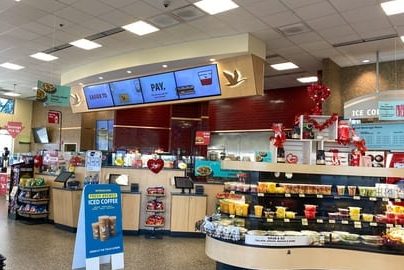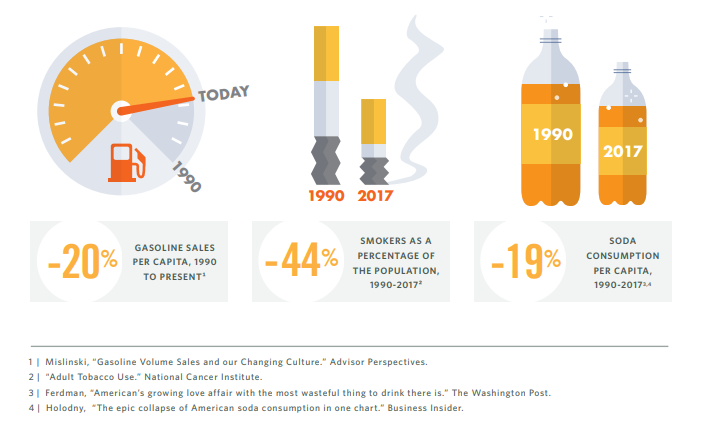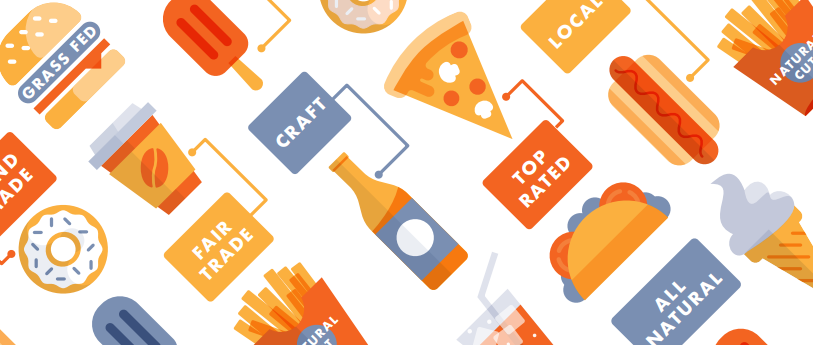
Convenience stores have long thrived on selling gas, cigarettes, and sodas.
In the Eastern U.S. some C-stores have built a strong following based on their food.
Out West, it seems that the stores’ biggest draw is still convenience—a value proposition that’s getting tougher to defend.
Read on to see how c-stores like Sheetz, Wawa, Green Zebra Grocery, and Food Fight! have adapted to:
- Dwindling revenue from ‘Cokes, Smokes, and Gas’
- Competition for Convenience Food
- Changes in Demographics
- Winning with Favorite Food & a Place to Eat It
And recent statistics continue to bear that out. According to the Convenience Store News 2018 Industry Report, total sales for the industry were $616.3 billion with fuel accounting for more than 63%. Of the remaining $226.9 billion (instore sales), cigarettes made up nearly 30%, and packaged (non-alcoholic) Convenience stores have long thrived on selling gas, cigarettes, and sodas. and fountain beverages contributed almost 14%.
However, sales of these items have stalled in recent years, and experts predict that significant changes in customer buying habits will soon require operators to look for new areas of revenue.

Frank Beard, an analyst at GasBuddy, a fuel pricing app says, “By and large, there’s sort of this perfect storm right now where, for years, the industry was relying unofficially on this model of ‘Cokes, smokes and gas’ where you’d have retailers selling fuel, having an interchangeable store offering from one store to the next.”
But as the above chart shows this model is likely running out of time. To face this challenge, the East Coast chains like Sheetz and Wawa have taken the bold step of adding made-to-order food centers in their stores. This was an expensive bet on QSR. And with significant investment needed in both equipment and personnel to achieve this capability, this is something that chains with stores on the West Coast have yet to embrace. Still, the latest data are showing this may be a big investment worth making.
“C-store monthly dining frequency has jumped by more than 13% in the past five years; meanwhile, other channels such as quick-service restaurants, grocery stores, and casual dining have stayed flat or declined.” ALIX PARTNERS 2017 NORTH AMERICAN CONVENIENCE STORE CONSUMER STUDY
SHARING THE AUTO INDUSTRY’S WOES
According to research by the NACS, loyal convenience store patrons are motivated by habit, often centered around driving to and from work. They found that frequent customers—those who stop in from several times a week up to several several times a day—are most often buying items to consume immediately in their car.
But America’s love affair with the car is undergoing a profound generational change, one that may soon affect convenience shopping behavior. If people make fewer single passenger trips past their local store, they’re less likely to stop in.
“Increasingly, car ownership is a luxury rather than a necessity. In urban areas, where more and more of the population lives, people can avoid parking costs and the expense of insurance by relying on ride services like Uber or Lyft or hourly rentals with services like Zipcar.” THE NEW YORK TIMES, “THE CAR INDUSTRY IS UNDER SIEGE”
COMPETITION FOR CONVENIENCE FOOD
One of C-stores’ consistent strengths in attracting business has been their ability to provide instant gratification. A customer knows he can run in, grab the food he what he wants, and get quickly on his way. But big changes in food preference and technology, including a number of apps that bring nearly any kind of food in a few taps, are set to take their toll on this once unassailable convenience.
According to CS News, with Amazon pioneering same-day delivery on a variety of items, and third-party delivery services partnering with QSRs, restaurants and other retailers, consumer expectation of delivery is making its way into every market.
This sea change is giving consumers quick access to any food they want, and that includes choices that many convenience stores simply don’t carry. For example, many people are now choosing less processed food for health reasons and using delivery services like GrubHub and UberEats to get them as quickly as a drive to the nearest C-store.
“If convenience stores want to compete and grow, they will need to increase their share of the food-service market, including adding healthier options.” MARIANNE WILSON, CHAIN STORE AGE
CHANGES IN DEMOGRAPHICS
Finally, there are big changes happening as a result of one generation replacing another. These demographic forces are the impetus behind the major changes now taking place in transportation and food preference.
Millennials (those born between 1981- 1996) now outnumber Baby Boomers (born between 1946-1964). And they’re not doing things like their parents. This next big generation is eschewing cigarettes and soft drinks, and hot dogs on a roller. They still want convenience food. They just want a fresher, healthier, natural version.
According to EuroMonitor, the new wave of customer preferences includes diets such as vegan, gluten-free, paleo, and organic. They report that “Millennial dietary habits stand to revolutionize a channel that has been anything but health-conscious in the past.”
WINNING WITH FAVORITE FOOD & A PLACE TO EAT IT
Several years ago both Sheetz and Wawa took the bold step of severing ties with established fast food partners and offering original made-to-order food in their stores. Additionally, they’ve continued to update their interiors and invested in seating areas where customers can stay and eat if they like. The result has been something of an anomaly in the C-store segment: strong customer loyalty based on brand rather than location.
“For years, the convenience food service trend has been more advanced on the East Coast, led by chains such as Sheetz and Wawa.” THE LINDA LISANTI
EDITOR-IN-CHIEF
CONVENIENCE STORE NEWS

A TEST IN THE WEST?
While Sheetz and Wawa have had success with QSR in the eastern U.S., no major chain has followed this blueprint out west. However, there are a few independent operators in this region who have had success with this strategy.
At Green Zebra Grocery, customers can choose from healthier takes on 7-Eleven classics like kombucha slushies and a full-service coffee bar, as well as fresh produce from local farms, bulk bin foods, vegan snacks, and offerings from local brands. The store is about to open its fourth location.
“We think of our stores as a human recharging station as opposed to the traditional convenience store, which tears down your health.” LISA SEDLAR
FOUNDER OF GREEN ZEBRA GROCERY
In an even a further departure from the typical C-store, Food Fight! offers its customers a mix of healthy and “junk” food, all made from plant-based ingredients. It also offers a limited selection of fresh produce and bulk bin options—another feature that customers are increasingly seeking out.
Customers will always want convenience. But more than that they are looking for the food that fits their taste and lifestyle. With few chain stores in the West Coast willing to try this option, this opportunity seems ripe for the taking.
Summary
West Coast convenience stores have traditionally relied on the “Cokes, smokes, and gas” model, but declining sales and changing demographics are making this strategy harder to defend. Eastern U.S. chains like Sheetz and Wawa have successfully invested in made-to-order food, seating, and healthier options, building strong brand loyalty. West Coast operators face an opportunity to expand into QSR offerings, fresh and healthier food options, and dining experiences to capture new revenue and engage customers.
Key Takeaways
- Traditional convenience store revenue from fuel, cigarettes, and sodas is declining, prompting the need for new revenue streams.
- Eastern chains like Sheetz and Wawa have built customer loyalty by offering made-to-order food, seating areas, and fresh options.
- West Coast C-stores largely remain convenience-focused, missing opportunities in the QSR and food-service market.
- Changing demographics, including Millennials favoring healthier, fresher, and plant-based foods, are reshaping consumer expectations.
- Delivery apps and technology-driven food options are raising the bar for convenience and speed, challenging traditional C-store models.
- Independent operators like Green Zebra Grocery and Food Fight! demonstrate that healthier and unique food offerings can succeed on the West Coast.
- There is a clear opportunity for West Coast C-stores to differentiate by offering favorite foods and a place to enjoy them.
Frequently Asked Questions
Q. Why are West Coast C-stores missing opportunities in QSR?
A. Most West Coast stores focus on convenience items like fuel, cigarettes, and soda, while Eastern chains have invested in made-to-order food and dining experiences, creating stronger customer loyalty.
Q. How have Eastern chains like Sheetz and Wawa succeeded in QSR?
A. They introduced made-to-order food, healthier options, updated interiors, and seating areas, creating a brand-driven experience that goes beyond convenience.
Q. What demographic changes affect convenience store shopping?
A. Millennials, who outnumber Baby Boomers, prefer healthier, fresher, plant-based foods and may rely less on cars, affecting traditional C-store foot traffic.
Q. How are technology and delivery apps influencing convenience shopping?
A. Apps like GrubHub, UberEats, and Amazon same-day delivery increase customer expectations for quick access to fresh food, challenging stores that rely solely on traditional convenience items.
Q. Are there successful examples of West Coast C-stores embracing QSR?
A. Yes. Independent operators like Green Zebra Grocery and Food Fight! offer healthier and unique food options, including plant-based items, fresh produce, and seating, showing the potential for success in this market.
